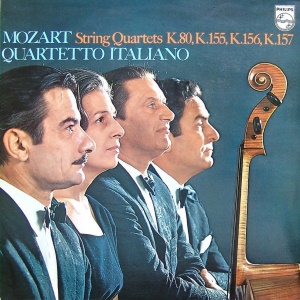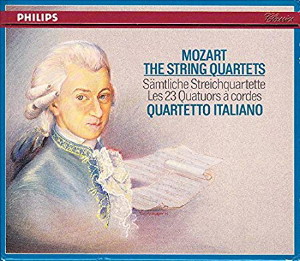 |
|
Philips
- 1 LP - 6500 142 - (p) 1971
|
 |
| Philips
- 8 CDs - 416 419-2 - (c) 1990 |
|
| Wolfgang Amadeus
Mozart (1756-1791) |
|
|
|
|
|
|
|
| String
Quartet No. 1 in G major, KV 80 |
|
15' 11" |
|
| -
Adagio |
6' 42" |
|
|
| -
Allegro |
3' 11" |
|
|
| -
Menuetto |
3' 05" |
|
|
| -
Rondo |
2' 13" |
|
|
|
|
|
|
| String
Quartet No. 2 in D major, KV 155 |
|
9' 39" |
|
-
Allegro
|
3' 34" |
|
|
| -
Andante |
4' 40" |
|
|
| -
Molto Allegro |
1' 25" |
|
|
|
|
|
|
| String
Quartet No. 3 in G major, KV 156 |
|
13' 37" |
|
| -
Presto |
3' 03" |
|
|
| -
Adagio |
6' 43" |
|
|
| -
Tempo di Menuetto |
3' 51" |
|
|
|
|
|
|
| Adagio
(Original Adagio from Quartet No. 3
in G major, KV 156) |
|
2' 44" |
|
|
|
|
|
| String
Quartet No. 4 in D major, KV 157 |
|
12' 18" |
|
| -
Allegro |
5' 22" |
|
|
| -
Andante |
5' 01" |
|
|
| -
Presto |
1' 55" |
|
|
|
|
|
|
QUARTETTO ITALIANO
- Paolo Borciani, Elisa Pegreffi, violino
- Piero Farulli,
viola
- Franco Rossi, violoncello
|
|
|
|
|
|
Luogo e data
di registrazione |
|
La-Chaux-de-Fonds
(Svizzera)
- 11-14
novembre 1970 |
|
|
Registrazione: live
/ studio |
|
studio |
|
|
Producer / Engineer |
|
Vittorio
Negri
|
|
|
Prima Edizione LP |
|
Philips
| 6500
142 | 1
LP | (p) 1971
|
|
|
Prima Edizione CD |
|
Philips | 416 419-2
| 8
CDs - (1°,
1-4, 5-7, 8-10,
11, 12-14) | (c)
1990 | ADD
|
|
|
Note |
|
-
|
|
|
|
|
Mozart's
first efforts in the
difficult art of composing
sreing quartets are not
very well known, havinf
been much overshadowed by
his later masterpieces in
the same medium. But they
contain much delightful
music, as well as
displaying the
never-failing fascination
of showing a great
composer's first attempts
in a medium in which he
was later to become one of
the greatest masters.
The
apparent ease of
Mozart's later
quartet-writing would have
been so much less
obvious were it not
for his first essays
in the new medium. And
it was a new
medium, in Mozart's
youth. The great Haydn
had begun to develop
it, certainly, from
earlier Italian and
Austrian models, but
even he had reached
only his Op. 9 by the
year 1770, when Mozart
wrote his own first
string quartet.
Mozart's
own early quartets,
written mostly with
an Italian public in
mind, and usually as
he was on his way to
Italy itself or
actually in the
country, seem to
hover between
serious chamber
music and orchestral
entertainment music
of the divertimento
kind. There is still
considerable
emphasis on the
first violin, and
less evidence of the
kind of intimate
instrumental
conversation which
became such a marked
feature of the
mature string
quartets of later
years. But the
rapidity of Mozart's
evolution as a
quartet composer is
very apparent, even
within these
earliest examples;
one has only to
compare the
alternative versions
of the E minor
Adagio, composed
within a few months
of each other, for
the third Quartet
(K. 156) to realise
the extraordinary
advance in depth and
seriousness which
the composer
achieved in a very
short period. The
earlier version has
a certain melodic
grace (how indeed
could it have been
otherwise, with
Mozart as its
composer?) but the
slightly later
version has not only
melodic beauty but
also a profundity
and technical
mastery which can
compare very
favourably with some
of Mozart's finest
later slow
movements.
As unknown
correspondent of
Dr. Burney,
writing from
Salzburg in
November 1772,
reported that in
his opinion, young
Mozart was "one
further instance
of early fruit
being more
extraordinary than
excellent." It was
just as well that
Burney concealed
this critic's
name, or it would
long since have
been covered in
opprobrium;
he seems, in any
case, to have
based his
conclusions on
some rather
hastily-gathered
evidence. Perhaps
if he had heard or
played these
string quartets,
he would have
changed his
opinion; no one,
surely, could hear
that wonderful
E minor Adagio
without being
much impressed.
Quartet
No. 1 in G, K.
80
Mozart's
first string
quartet was
written or at
least begun,
"at seven in
the evening"
on March 15,
1770, in the
North Italkian
city of Lodi,
rendered
famous a
quartet of a
century or so
later by
Napoleon's
exploit at its
bridge. It
seems to have
been peaceful
enough on that
March evening
in 1770, when
Mozart and his
father halted
there on their
first journey
to Italy.
The
quartet opens,
like an
Italian notturno,
with a slow
movement based
on one of
Mozart's
favourite
melodic
clichés, which
many will
associate with
his later use
of it for the
Countess's
aria "Porgi
amor" in
"Figaro." The
movement as a
whole is in
binary form,
with two
balancing
halves or
"strains" of
music, each of
which can be
repeated. As
in some of
Domenico
Scarlatti's
sonatas, the
main theme
does not
return in the
second half. A
jolly,
bustling
sonata-form Allegro
follows, also
in two
strains, with
a short,
slightly
contrapuntal
development
section. The
subsequent Menuetto
and trio are
quite regular
in
construction,
the Menuetto
being
repeated, to
form the
original
finale. Later
Mozart added
the Gavotte-en-rondeau
which now
serves as a
finale;
besides being
a lively,
country-dance
kind of
gavotte, it is
interesting as
an
illustration
of Mozart's
technical
evolution as a
quartet
composer.
Quartet
No. 2 in D, K.
155
The
second quartet
was written
about 1772,
probably in
northern
Italy. It is
extremely
Italianate,
being rather
like a
three-movement
sinfonia
for strings.
But some
elaborate
passages for
the viola, in
the first
movement,
reveal that
this was
really meant
as a true
string quartet
and not an
orchestral
piece. That
first movement
is in full
(and very
neat) sonata
form, but with
a wealth of
melodic
subjects far
beyond the two
or three
advocated in
the textbooks.
The Andante
is a lyrycal
movement in
binary form,
with repeats ad
lib.
For a finale,
Mozart gives
us a gay and
lively rondo,
with three
episodes
between the
repeats of the
main tune.
Quartet
No. 3 in G, K.
156
There
is a
serenade-like
quality about
the joyous
opening
movement of
the third
quartet. Its
artless
melodies are
as full of
Mediterranean
charm as those
of
Mendelssohn's
"Italian"
Symphony.
Officially it
is in sonata
form, with
theusual
exposition,
development,
and
recapitulation,
plus double
bars and
repeat signs,
for this
apparently
easygoing
piece is
constructed
with all
Mozart's usual
formal
mastery; the
development
section is
quite long for
Mozart - some
37 bars, in
fact, but who
cares about
sober figures
when Mozart's
youthful
genius pours
out such
enchantment in
this initial Presto?
As
mentioned
already,
Mozart
composed two
slow movements
for
this quartet,
one at the end
of 1772, and
the other
early the
following
year. The
first is
competent
enough, but
the second
version is of
quite
unexpected
beauty and
power. It is
this second
slow movement
which is
played here,
but the
original Adagio
is also
included,
for interest's
sake, after
the finale.
The
final movement
itself is a
stately minuet
and trio, the
latter being
in the minor
key. Lovers of
Mozart's comic
opera "Così
fan tutte" may
hear some
resemblances
to one of its
arias in the
codetta of
this minuet.
Quartet
No. 4 in C, K.
157
This
quartet,
composed c.
1772-73 in Milan,
is a true
string
quartet, with
much close
interolay
between the
four instruments.
The first
movement is in
sonata form,
with easily
remembered
themes, and
with repeat
marks
outlining the
two "strains."
A simple Andante
follows, with
a short
codetta to
round off its
melodious
phrases and
rich
harmonies. The
finale is a
light-hearted
rondo, with a
little
surprise
codetta al the
very end.
Charles
Cudworth
|
|
|